

Avid 0.15 EC Miticide Insecticide. Avid 0.15 EC is an emulsifiable concentrate containing 0.15 lb. abamectin/gal. which, when mixed with water, will control leafminers and mites and suppress whiteflies, thrips, and aphids on ornamentals.
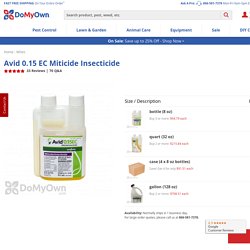
Mix with water and apply as a foliar spray to obtain uniform coverage. For mites, apply when mites first appear and repeat as necessary to maintain control. For leafminers, apply as needed and repeat at 7-day intervals or as necessary to maintain control. For suppression of aphids, thrips, and whiteflies, apply when young, immature stages of these pests are first observed and repeat every 7 days for 2 or 3 weeks. After which time, rotate to other products that have different modes of action than Avid 0.15 EC for at least 2-3 weeks.
Residual control of pests may be enhanced with the addition of a horticultural spray oil at 0.5 to 1.0% of the spray volume on field-grown woody ornamentals, landscape plants, and Christmas trees. How to make a white garden — Arthur Road Landscapes demo. Phytophthora Fungus Information - Tips For Controlling Phytophthora Root Rot. It’s a gardener’s worst nightmare — a young tree, lovingly established and bathed with affection refuses to come into its own, instead collapsing several years after planting.

The tree didn’t have problems with insects or any visible diseases, it just faded away. Azalea Bushes And Phytophthora Root Rot. Japanese Beetle Management. **** Helpful, clear. **** Imp. List of avail. fungicides (2002) Fire Blight, Apple Scab, Rust, Plus Others: Be On Alert! Diseased hawthorn tree. George WeigelCedar-apple rust on a crabapple leaf.
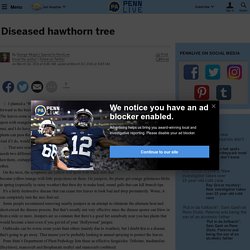
Q: I planted a ‘Winter King’ hawthorn tree 5 years ago and was looking forward to the beautiful red winter fruits. But it is looking worse each year. The leaves come out in spring green enough but quickly get brownish black spots with orangeish little spikes. Powdery Mildew/ Dogwood. Flint e. Fungicides. Walmart. Apple Scab - Apple Best Practice Guide. Scab lesions on fruit.
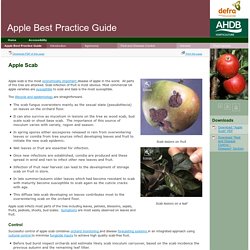
Apple scab management options for high inoculum orchards. Identification. DevelopmentofSerenadeasabiopesticideagainstplantbacterialdiseases. Fire blight : Integrated Pest Management for home apple growers. Extension > Garden > Yard and Garden > Fruit > Apple pest management in Minnesota home orchards > Fire Blight Back to Apple pest management in Minnesota home orchards.
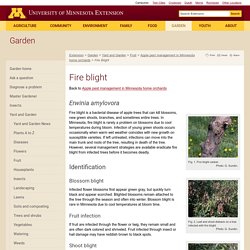
Apple scab : Integrated Pest Management for home apple growers. Extension > Garden > Yard and Garden > Fruit > Apple pest management in Minnesota home orchards > Apple scab Back to Apple pest management in Minnesota home orchards Fig. 1.
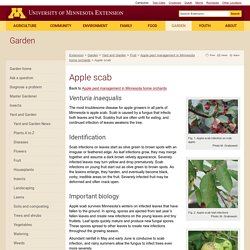
Apple scab infection on crab apple. Conversions + which chemical for which plant/ disease. 2014 ag chem tables 10 12 13 14. Conversion of large mix ratios for small sprayers❗️ What Can Phosphonates Do For You? – (Fosetyl) A new way to look at one of our most trusted chemical classes.

The United States was introduced to phosphonates in the 1980s when Rhone Poulenc introduced Aliette 80WP. How to Treat & Prevent Fire Blight in Your Organic Orchard. Copper Sulfate/ Human Toxicity! As of 2011, NPIC stopped creating technical pesticide fact sheets.
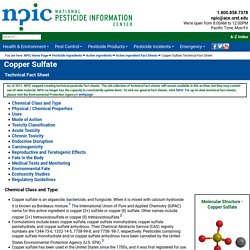
The old collection of technical fact sheets will remain available in this archive, but they may contain out-of-date material. NPIC no longer has the capacity to consistently update them. To visit our general fact sheets, click here. For up-to-date technical fact sheets, please visit the Environmental Protection Agency’s webpage. Streptomycin(Fertilome F. Blight) Breaks down in sun/ Apply after sundown! TreeGeek CuPROProductGuide. Fireblight. It's Spring! Time to Oil Up. FUNGICIDES AND SPRAY GUIDE. HGIC 2208 Fire Blight of Fruit Trees. Pesticides updated by Joey Williamson, Horticulture Turf Extension Agent, Clemson University, 11/17.
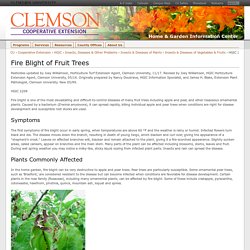
Revised by Joey Williamson, HGIC Horticulture Extension Agent, Clemson University, 05/16. Originally prepared by Nancy Doubrava, HGIC Information Specialist, and James H. Blake, Extension Plant Pathologist, Clemson University. HGIC 2208 Fire Blight of Fruit Trees. Notes on Fire Blight Control from a Plant Pathologist. Notes on Fire Blight from Elizabeth L.

Little, Assistant Professor – Homeowner IPM/Sustainable Agriculture, UGA The time to think about fireblight management using sprays is just before and during bloom, so late March may be too late for most trees. Once the bacterium gets into the blooms there is not much to be done except to cut out any diseased branches later in the year. A streptomycin spray could be applied as blooms fall for secondary spread, but most of the damage has probably been done at that point, depending on whether it was a bad year. Chemicals for Plant Disease Control at Home.
The complex action of phosphonates as an20160205 30232 nvp1f9. Aliette label. Aliette label. 2018 Fungicide. Disease Update: The Fire Blight Saga Continues. Aliette pib 150. Fosetyl Label. Chapin Slide Pump Sprayer 6002, Chapin Sprayers. The Chapin Slide Pump Sprayer offers maximum portability and can be used in any container simply by dropping the weighted strainer into the solution and pumping with the slide pump.
The sprayer features an 84in heavy duty nylon reinforced chemical resistant hose and a brass adjustable nozzle for fine mist to coarse stream. The brass pump develops pressure up to 150 psi and allows you to reach targets over 30 feet away! Perfect for spraying the eaves of your home or any hard to reach areas. Chapin Slide Pump Sprayer “Hi, I’m Michael with Do My Own Pest Control, and this is a product snapshot of the Chapin Side Pump Sprayer. Fsa 7564. Fungicides Made Simple. Disease is a major source of plant damage in roses with the most common rose diseases being caused by fungus.
While some rarely-contracted rose diseases are caused by viruses or bacteria, more often than not, it is fungi that wreak havoc in our rose gardens. Nationwide, blackspot fungus (Diplocarpon rosae Wolf) is the most common rose disease. Center for Agriculture, Food and the Environment UMass Amherst. Sooty mold is a dark colored fungus that grows on honeydew excreted by piercing sucking insects or on substances exuded from leaves of certain plants. Common genera of sooty mold fungi found are Aethaloderma, Capnodium, Cladosporium, Euantennaria, Scorias, and Trichomerium.
Host Plants Sooty mold fungi are decomposers that break down honeydew or naturally exuded plant materials as their source of nutrition. They do not directly draw any sustenance from the host plant on which they reside. However, sooty mold that covers leaves blocks light and makes photosynthesis less efficient. Center for Agriculture, Food and the Environment UMass Amherst. The fungus Discula destructiva causes dogwood anthracnose leaf blight and canker.
Host Plants Dogwood anthracnose infects flowering (Cornus florida) and Pacific dogwoods (C. nuttallii). Kousa dogwood (C. kousa) is also susceptible to infection but the disease is usually limited to leaf spotting. Description Susceptible trees commonly have spotted leaf and flower bracts in late spring and early summer, but during wet springs, leaf and twig blights often occur. Vascular cambium infected with dogwood anthracnose is chocolate brown in contrast to the pale tan color of healthy sapwood. Magnolia Scale/ use drench in June! As its common name suggests, Magnolia scale, Neolecanium cornuparvum, is a frequent pest of magnolia species, including star magnolias, saucer magnolias, and cucumber tree. These large, easily seen insects cause damage to trees by attaching themselves to the tree’s vascular system and feeding on the sap. They can kill entire branches and weaken the tree.
Pine Wilt. CuPRO 5000 T/N/O. Mancozeb, a fungicide routinely used in agriculture, worsens nonalcoholic fatty liver disease in the human HepG2 cell model. Bonide Mancozeb Flowable with Zinc Concentrate Help - Questions and Answers - DoMyOwn.com. Cuprofix Brochure Revised January 2018. Early-season copper use strategies in apple disease control. Prevent fruit tree insects and disease. Managing foliar fungal diseases: Timing is everything. While robins may be a herald of spring, a sure sign that summer has arrived is the barrage of visits to my office from alarmed tree owners. They arrive with plastic bags of crumpled leaves and concerned looks on their faces. Almost to a person, they have two questions on their mind: "What is killing my tree? " Center for Agriculture, Food and the Environment UMass Amherst. Verticillium wilt/RHS Gardening. Non-chemical control. Keeping needles on Japanese black pines from turning brown.
p2827 Hawthorns 2018❗️ Dogwood Diseases. Apple scab on hawthorn leaves. Designing with Ornamental Grass and some BFFs. I have been enamored with Ornamental Grasses since I was exposed to them while working my first nursery job in California. Marin Rose Society - Spider Mites. Spider mites are small arachnids related to spiders and are common in low rainfall areas of the West where warm summer temperatures (above 70°F) and dry plant foliage favor their development. Ep 020: Plant One On Me: Troubleshooting basic houseplant problems. Ep 015: Plant One On Me: Mealybugs, gnats and spider mites—oh my!
Systemic pesticides- how, when, and why. Cactus pest control. NutriRoot - Winter Webinar 2017. PHOSPHO-jet - Winter Webinar 2017. Arborjet. Anthracnose - Arborjet. Anthracnose (leaf blight) is a fungus that winters on twig tissue on the tree. In the spring, spores are transported to new buds and shoots. The disease is enhanced by cool, wet conditions. Infected leaves develop tan to reddish brown lesions that extend along the veins of the leaf. Considerable defoliation, sometimes with complete leaf loss, occurs on many trees by late spring in cool, wet years. Verticillium Wilt. Bacterial Wetwood. Bacterial wetwood, also known as slime flux, is caused by an infection of one or more of several bacteria.
It results in a water-soaked, oozing or bleeding condition of wood, which occurs in the trunk, branches and roots of shade and ornamental trees. It is normally not serious in most trees but is a chronic disease, which causes concern and can contribute to a general decline in tree vigor over time. Psyllid Pests – Information And Treatment For Psyllids In Plants. Awabuki Diseases Causing Leaf Drop.mov. Viburnum Leaf Beetle (VLB), Cornell University. Pinterest. Talstar XTRA Granular Insecticide – Fast Fire Ant Control. Trees and shrubs: establishment problems. Conifers: Pestalotiopsis disease/RHS Gardening. Aphids Management Guidelines. San Diego Master Gardeners - FAQ - White cottony substance on my pyracantha. Arborvitae dying in only one spot-why? - Ask an Expert. Dying arborvitae hedge - Ask an Expert.
Hidden Valley Hibiscus Wake-Up Spray. Hidden Valley Hibiscus - Hibiscus Doctor. Hidden Valley Hibiscus ~ Snow Scale. Look Closely for Lace Bugs. Insect Borers of Trees and Shrubs. Siting a Garden Shed on Your Property. Japanese Beetle Problem? Try Geraniums and Milky Spore. Plant problem diagnostic tool / UC IPM: Home, garden, turf and landscape. Pesticide information - UC Statewide IPM Program. UC ANR Online Learning: Log in to the site. Online training - UC Statewide IPM Program. Plant problem diagnostic tool / UC IPM: Home, garden, turf and landscape. Bordeaux Mixture. Pine Diseases. Brown Spot Needle Blight of Pines. Neem Oil Uses: Using Neem Oil Insecticide In The Garden.